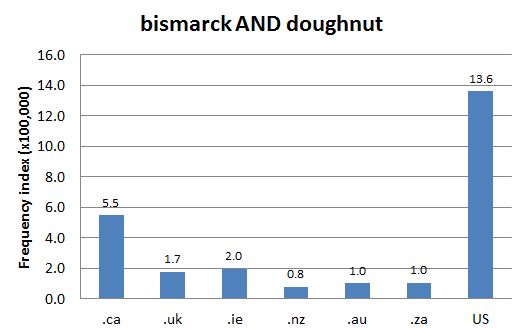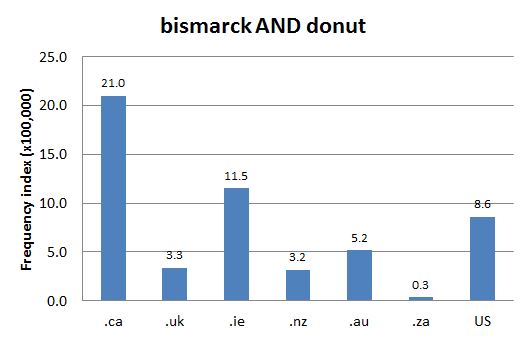DCHP-2
bismarck DCHP-2 (October 2016)
n. — Prairies, Food
a donut without a hole, filled with either jam or cream (see Image 1).
Type: 3. Semantic Change — The term is semantically versatile. According to COD-2, bismarck refers to a "sugar-coated jam-filled doughnut" in Alberta, Saskatchewan, and in the US Midwest ("chiefly Upper Midwest and western Great Lakes", DARE). In Manitoba, however, it refers to a "cream-filled doughnut, often with chocolate glaze" (see COD-2, s.v. "bismarck" [1 & 2]). These claims are difficult to evaluate, as the term is usually used without an explanation of which type of doughnut is being referred to. Bismarck occurs in two meanings in the US: besides a jelly-filled donout, it is also an oblong donut (DARE, s.v. "Bismarck"). A prevalence of spellings can be reported that reveals a Canadian dimension: when coupled with the term doughnut, bismarck has a higher frequency in the US (see Chart 1). But when paired with donut, the term has a higher frequency in Canada (see Chart 2, see also Charts 2 & 3 at Timbits). In all likelihood, the meaning 'jam-filled donut' is a North American term. Bismarck in Manitoba appears to have undergone a localized semantic change.
The name may be linked to Germany's first chancellor Otto von Bismarck, governing from 1871-1890, who is said to have taken a liking to them. While the period coincides with German out-migration to Canada and US, no reliable source could be found to confirm this origin.
See also ITP Nelson, s.v. "bismarck", which is marked "Prairie Canada", DARE, s.v. "bismarck n.", which marks it as "chiefly Upper Midwest, wGreat Lakes"See also: Burlington bun jambuster Timbits (Charts 2 & 3)
- A bismarck is only one of many names for this type of filled doughnut (e.g. Krapfen, Berliner and many others), but the name that was propagated by the German-speaking migrants to Central Canada and that spread into Canadian English was bismarck.
References:
Images:

Image 1: Type of donut very similar to bismarcks. Source: Wikimedia Commons. Photo: McZusatz)
Chart 1: Internet Domain Search, 11 Sep. 2013
Chart 2: Internet Domain Search, 11 Sep. 2013

